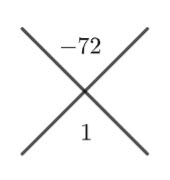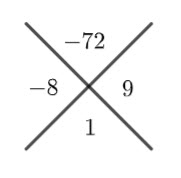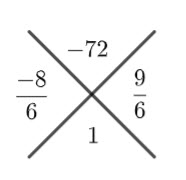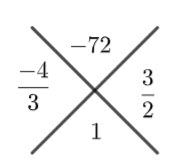The general equation of a quadratic is ![]()
Let’s explore different methods of factorising a non-monic quadratic (the ![]() term is not
term is not ![]() )
)
Factorise ![]()
We need to find two numbers that add to ![]() and multiply to
and multiply to ![]() (i.e. add to
(i.e. add to ![]() and multiply to
and multiply to ![]()
The two numbers are ![]() and
and ![]()
Method 1 – Splitting the middle term
This is the method I teach the most often
![]()
Split the middle term (the ![]() term) into the two numbers
term) into the two numbers
![]()
The order doesn’t matter.
Find a common factor for the first term terms, and then for the last two terms.
![]()
There is a common factor of ![]() , factor it out.
, factor it out.
![]()
Method two – Fraction
![]()
Put ![]() into both factors and divide by
into both factors and divide by ![]()
![]()
Factorise
![]()
![]()
![]()
Method 3 – Monic to non-monic
![]()
Multiply both sides of the equation by ![]()
![]()
![]()
![]()
Let ![]()
![]()
Factorise
![]()
Replace the ![]() with
with ![]()
![]()
![]()
![]()
![]()
Method 4 – Cross Method
![]()
Place the two numbers in the cross

Place the two numbers that add to ![]() and multiply to
and multiply to ![]() in the other parts of the cross.
in the other parts of the cross.

Divide these two numbers by ![]() (i.e
(i.e ![]() )
)

Simplify

Hence,
![]()
Which is
![]()
Method 5 – By Inspection
This is my least favourite method – although students get better with practice
![]()
The factors of ![]() are
are ![]() and
and ![]() and the factors of
and the factors of ![]() are
are ![]()
We know one number is positive and one number negative.
Which give us all of these possibilities
| Possible factorisations | ||
| No | ||
| No | ||
| No | ||
| No | ||
| No | ||
| Almost, switch the signs | ||
| Yes |
![]()
With a bit of practice you don’t need to check all of the possibilties, but I find students struggle with this method.
Method 6 – Grid
![]()
Create a grid like the one below
Find the two numbers that multiply to ![]() and add to
and add to ![]() and place them in the other grid spots (see below)
and place them in the other grid spots (see below)
Find the HCF (highest common factor) of each row and put in the first column.
Row ![]() HCF=
HCF=![]() , Row
, Row ![]() HCF=
HCF=![]()
For the columns, calculate what is required to multiple the HCF to get the table entry.
For example, what do you need to multiple ![]() and
and ![]() by to get
by to get ![]() and
and ![]() ? In this case it is
? In this case it is ![]() . It’s always going to be the same thing, so just use one value to calculate it,
. It’s always going to be the same thing, so just use one value to calculate it,
The factors are column ![]() and row
and row ![]()
![]()
The two methods I use the most are splitting the middle term, and the cross method, but I can see value in the grid method.
